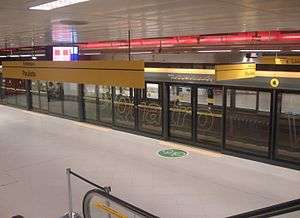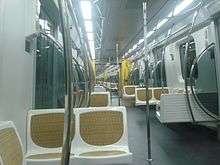Line 4 (São Paulo Metro)
| São Paulo Metro Line 4 (Yellow) | |||||||||||||||||||||||||||||||||||||||||||||||||||||||||||||||||||||||||||||||||||||
|---|---|---|---|---|---|---|---|---|---|---|---|---|---|---|---|---|---|---|---|---|---|---|---|---|---|---|---|---|---|---|---|---|---|---|---|---|---|---|---|---|---|---|---|---|---|---|---|---|---|---|---|---|---|---|---|---|---|---|---|---|---|---|---|---|---|---|---|---|---|---|---|---|---|---|---|---|---|---|---|---|---|---|---|---|---|
 | |||||||||||||||||||||||||||||||||||||||||||||||||||||||||||||||||||||||||||||||||||||
|
| |||||||||||||||||||||||||||||||||||||||||||||||||||||||||||||||||||||||||||||||||||||
| Overview | |||||||||||||||||||||||||||||||||||||||||||||||||||||||||||||||||||||||||||||||||||||
| Type | Rapid transit | ||||||||||||||||||||||||||||||||||||||||||||||||||||||||||||||||||||||||||||||||||||
| System | São Paulo Metro | ||||||||||||||||||||||||||||||||||||||||||||||||||||||||||||||||||||||||||||||||||||
| Status |
Partially in operation, partially in construction, partially in planning | ||||||||||||||||||||||||||||||||||||||||||||||||||||||||||||||||||||||||||||||||||||
| Locale | São Paulo, Brazil | ||||||||||||||||||||||||||||||||||||||||||||||||||||||||||||||||||||||||||||||||||||
| Termini |
Butantã Paulista | ||||||||||||||||||||||||||||||||||||||||||||||||||||||||||||||||||||||||||||||||||||
| Stations | 11 | ||||||||||||||||||||||||||||||||||||||||||||||||||||||||||||||||||||||||||||||||||||
| Operation | |||||||||||||||||||||||||||||||||||||||||||||||||||||||||||||||||||||||||||||||||||||
| Opened | May 25, 2010 | ||||||||||||||||||||||||||||||||||||||||||||||||||||||||||||||||||||||||||||||||||||
| Operator(s) | ViaQuatro | ||||||||||||||||||||||||||||||||||||||||||||||||||||||||||||||||||||||||||||||||||||
| Technical | |||||||||||||||||||||||||||||||||||||||||||||||||||||||||||||||||||||||||||||||||||||
| Line length | 12.8 km (8.0 mi) | ||||||||||||||||||||||||||||||||||||||||||||||||||||||||||||||||||||||||||||||||||||
| Track gauge | 1,435 mm (4 ft 8 1⁄2 in) standard gauge[1] | ||||||||||||||||||||||||||||||||||||||||||||||||||||||||||||||||||||||||||||||||||||
| Electrification |
750 VDC Third rail bottom contact | ||||||||||||||||||||||||||||||||||||||||||||||||||||||||||||||||||||||||||||||||||||
| |||||||||||||||||||||||||||||||||||||||||||||||||||||||||||||||||||||||||||||||||||||


Line 4 (Yellow) is a line of the São Paulo Metro, originally called Southeast-Southwest Line. When finished, it will go from Luz to Vila Sônia. The first stretch, between and Faria Lima and Paulista stations, opened on May 25, 2010. Two other stations, Butantã and Pinheiros, were opened in July 2011. Today, the line goes from Butantã to Luz. It is expected that the line will be fully completed by 2015. It is operated by ViaQuatro, a private company which won the public-private partnership to operate Line 4 for 30 years, which can be renewable for another 30 years. Companhia do Metropolitano de São Paulo monitors the operation.[2]
History
Conceived since the years 1940s, the route of Line 4-Yellow was present in all studies for deployment of the Metro in São Paulo since. This road was consolidated in 1968 when the initial studies for the implementation of the current subway network, receiving at that time, the name of Southeast-Southwest Line. In parable form, would connect the neighborhoods of Pinheiros and Sacomã, from Jóquei Clube station to Via Anchieta station, through the Downtown, cutting East-West line of the Metro in República and Pedro II stations. Integration platforms came to be built in those two stations, but were not used. The Republic station platforms, built in the 1980s, with a further configuration of line 4, would be demolished for the passage of the tunneling machine, equipment that built the tunnel of Line 4 between Faria Lima and Luz stations, those from Pedro II station became a depôt. The consolidation of the project was only in 1993, when the basic design was first developed, already no longer including the Southeast portion, embedded in other policies of the Metro expansion and improvement of commuter trains.
Even in the 1990s, the Metro considered taking Line 4 to Tatuapé station, with the intent to relieve the Line 3-Red. This idea was discarded, having been replaced by a possible expansion of the Line 2-Green until that section. The construction of the Expresso Tiradentes (formerly Fura-Fila), designed in the administration of mayor Celso Pitta and the first section delivered in 2007, further reinforced the intention to build Line 4 only in the vector southwest of the city, from Luz Station.
Accidents
On January 12, 2007, during the construction of Pinheiros station, a large part of the site's access tunnel collapsed, opening an 80 m (265 ft) diameter crater, killing seven people.[3] Several houses and vehicles were swallowed by the hole, including a minibus; four of the victims were inside. A lot more houses suffered heavy damage, with several of these being declared condemned. Following Pinheiros' accident, Época magazine, aside Rede Globo, made a series of revelations about the security of the other line's stations, then still in building stage, dispensing special attention to the Paulista station, at Consolação quarter, a more heavily populated area, where a crater like that would have claimed a lot more lives.
The line's works were kept paralysed for about two months. Because of the press' accusations, the timetable was delayed for about four months, and Pinheiros construction could only be resumed after the end of the analysis procedures designed to discover the accident's cause. The reports were delivered in August, 2008, representing a delay of almost two years on the station's works. After work on the line resumed, two teams were digging the tunnel (one from each end, planning to meet in the middle). As they approached the meeting point, it was noted that there was an error of 80 cm (2.6 ft) between the tunnels.[4] During April, 2010, at the site of São Paulo: Morumbi station, a 30 m (100 ft) crane fell while hoisting building material from the bottom of the site. The crane fell across the pavement of Ave Prof. Francisco Morato; there were no injuries and work was not interrupted.[5]
Investigation
The whole construction work, carried out by Camargo Corrêa enterprises, is under suspicion of irregularities, according to the São Paulo's Public Ministry, in conformity to investigations done at the Operação Castelo de Areia (Portuguese for "Operation Sand Castle") carried out by the Brazilian Federal Police.[6]
Stations
| Code | Station | Platforms | Position | Connections | District |
|---|---|---|---|---|---|
| LUZ | Luz | Side platforms | Underground | Line 1 (Blue), CPTM Lines: Line 7 (Ruby), Line 10 (Turquoise) , Line 11 (Coral) | Bom Retiro |
| REP | República | Side platforms | Underground | Line 3 (Red) | República |
| HIG | Higienopólis-Mackenzie | Side platforms | Underground | Line 6 (Orange) | Consolação |
| PTA | Paulista | Side platforms | Underground | Line 2 (Green) | Consolação |
| FRE | Oscar Freire | Side platforms | Underground | Jardim Paulista | |
| FRA | Fradique Coutinho | Side platforms | Underground | Pinheiros | |
| FAL | Faria Lima | Side platforms | Underground | Bus Terminal | Pinheiros |
| PIN | Pinheiros | Side platforms | Underground | Line 9 (Emerald) | Pinheiros |
| BUT | Butantã | Side platforms | Underground | Urban bus terminal | Butantã |
| MBI | São Paulo-Morumbi | Side platforms | Underground | Line 17 (Gold), Urban bus terminal | Morumbi |
| VSO | Vila Sônia | Side platforms | Underground | Bus terminals for SPTrans e EMTU | Vila Sônia |
Expansion
A proposed extension is planned from Luz to Isolina Mazzei. Another extension is planned from Vila Sonia to Embu Das Artes.
References
- ↑ Ferreira, Robert; Tharcisiu Alves. (January 2012). "São Paulo Metro". www.nycsubway.org. www.nycsubway.org. Archived from the original on 2014-02-02. Retrieved 2014-02-02.
On Lines 1, 2 and 3, the track gauge is a non standard 1600 mm, the third rail is 750 V DC and under running. For Lines 4 and 5, the track gauge is 1435 mm and they use overhead pantograph, precluding any connection to the rest of the system, plus the 4 and 5 lines can't connect because the trains on the 4 line use drive-less technology while trains on 5 line are OPTO. Lines 7, 8, 9, 10, 11 and 12 (operated by CPTM) are all 1600mm and use overhead pantograph.
- ↑ Line 4 - Yellow - São Paulo Metro
- ↑ See the Wikinotícias (Portuguese Wikinews) thread about the accident.
- ↑ "Metrô: erro é 'incompatível' com estágio atual da engenharia". G1. 20 September 2007. Retrieved 2010-06-16.
- ↑ Estadão Online (in Portuguese)
- ↑ Folha Online (in Portuguese)
| Wikimedia Commons has media related to Line 4 (São Paulo Metro). |
